For those seeking a comprehensive understanding of the complex worlds of investment banking and private equity, the book ‘Financial Modeling and Valuation A Practical Guide to Investment Banking and Private Equity‘ serves as an illuminating guide. Whether you are a seasoned financial expert or an aspiring analyst, the book provides valuable insights that are worthy of exploration.
Introduction to Financial Modeling
Financial modeling is a critical skill in finance. It involves the creation of a summary of a company’s expenses and earnings in the form of a spreadsheet. This spreadsheet is used to calculate the impact of a future event or decision. Understanding how to create a financial model can be instrumental in making informed financial decisions.
Key Concepts in Valuation
The book dives deeply into valuation methods, which are essential for determining the worth of businesses. These methods are vital for investment banking professionals who require accurate assessments of a company’s value to make sound investment recommendations. The book emphasizes that mastering these techniques is crucial for success in the industry.
Investment Banking Essentials
Within its pages, the book offers a practical guide to the core functions of investment banking. From advising clients on mergers and acquisitions to underwriting, there’s much to glean about the strategic decision-making processes involved in this sector.
Understanding Private Equity
Private equity is another focal point of the book, which details its role in financing, restructuring, and improving companies. Readers will find a detailed explanation of how private equity firms operate and their impact on businesses and markets.
Critical Analysis
While the book is a treasure trove of knowledge, it does not shy away from the challenges and complexities of these financial domains. The author presents an optimistic view while encouraging readers to discern the nuances and apply critical thinking.
In-depth Examples
Rich with examples, this book offers real-world scenarios and case studies that bridge the gap between theory and practice. These examples are particularly beneficial for creative writers who seek to understand the finance industry’s intricacies in a more story-driven manner.
User-friendly Approach
One of the most engaging aspects of the book is its accessible language. Even complex concepts are explained in a manner that is comprehensible to those new to finance. This attribute broadens its appeal to a diverse audience.

Introduction to Financial Modeling
For those interested in further exploring financial literature, consider reading I Will Teach You, an insightful guide to personal finance, or Get a Grip on Your Business to understand business dynamics better. Additionally, explore the Books Everyone Should Read for curated literary gems that enhance financial knowledge.
Conclusion
‘Financial Modeling and Valuation A Practical Guide to Investment Banking and Private Equity‘ stands as a significant resource for anyone keen to deep dive into the world of finance. Its structured approach ensures that readers gain both knowledge and confidence in applying financial modeling and valuation techniques effectively.
FAQ
Who would benefit most from reading this book?
Anyone with an interest in investment banking or private equity, including students, financial analysts, and those looking to transition into the finance sector, will find it beneficial.
What are the book’s unique features?
Its unique features include practical examples, easy-to-understand language, and a comprehensive look at both financial modeling and valuation tactics.
Is prior knowledge of finance necessary?
While prior knowledge is helpful, it is not essential. The book’s language and examples are designed to be accessible to beginners as well.







